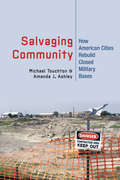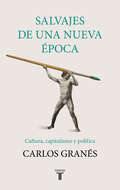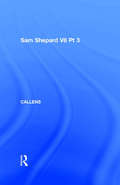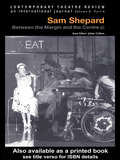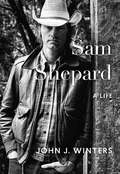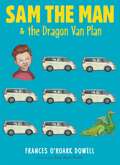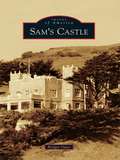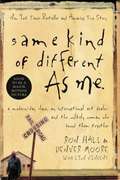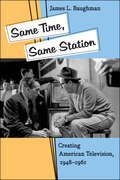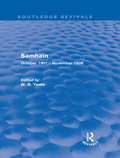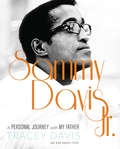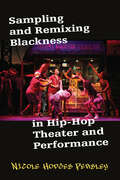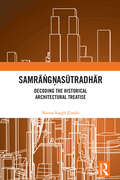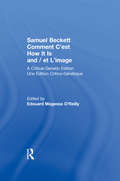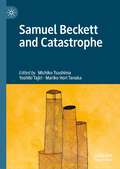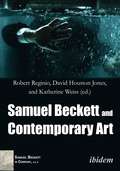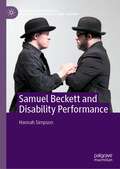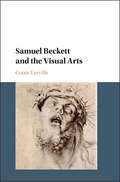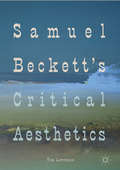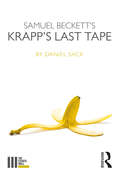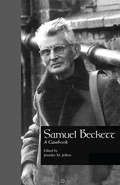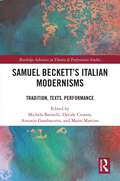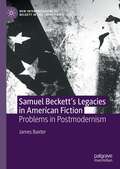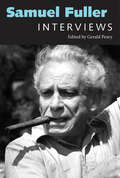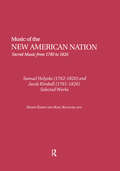- Table View
- List View
Salvaging Community: How American Cities Rebuild Closed Military Bases
by Michael Touchton Amanda J. AshleyAmerican communities face serious challenges when military bases close. But affected municipalities and metro regions are not doomed. Taking a long-term, flexible, and incremental approach, Michael Touchton and Amanda J. Ashley make strong recommendations for collaborative models of governance that can improve defense conversion dramatically and ensure benefits, even for low-resource municipalities. Communities can't control their economic situation or geographic location, but, as Salvaging Community shows, communities can control how they govern conversion processes geared toward redevelopment and reinvention.In Salvaging Community, Touchton and Ashley undertake a comprehensive evaluation of how such communities redevelop former bases following the Department of Defense's Base Realignment and Closure (BRAC) process. To do so, they developed the first national database on military redevelopment and combine quantitative national analyses with three, in-depth case studies in California. Salvaging Community thus fills the void in knowledge surrounding redevelopment of bases and the disparate outcomes that affect communities after BRAC. The data presented in Salvaging Community points toward effective strategies for collaborative governance that address the present-day needs of municipal officials, economic development agencies, and non-profit organizations working in post-BRAC communities. Defense conversion is not just about jobs or economic rebound, Touchton and Ashley argue. Emphasizing inclusion and sustainability in redevelopment promotes rejuvenated communities and creates places where people want to live. As localities and regions deal with the legacy of the post-Cold War base closings and anticipate new closures in the future, Salvaging Community presents a timely and constructive approach to both economic and community development at the close of the military-industrial era.
Salvajes de una nueva época
by Carlos GranésAl analizar las tensas relaciones entre producción cultural, capitalismo y ciertas ideologías actuales, Carlos Granés ofrece un certero diagnóstico del presente y una original mirada al arte contemporáneo. «La gracia del arte radica en que es la actividad libre por excelencia. Pero esta actividad libérrima y creativa ha sido rondada permanentemente por dos amantes peligrosas. La política y el capitalismo han tratado de multiplicar sus fuerzas fundiéndose con ella.» Comerciantes de arte roban paredes y puertas con obras de Banksy, un festival erótico disecciona los males políticos de España para estimular el consumo de pornografía, un autobús tránsfobo hace las veces de instalación itinerante, se estetiza el espacio público en Cataluña para hacer invisible al adversario... En los últimos años la cultura ha trabado una relación asfixiante con el capitalismo y con la política. Pareciera que el destino de toda expresión artística es acabar convertida en una mercancía cultural, en un incentivo para el turismo o en un arma estratégica en las batallas ideológicas. Este estupendo ensayo examina las tensiones entre la cultura, el mercado y el populismo contemporáneo. Carlos Granés ofrece un certero diagnóstico del presente y nos muestra con contundentes ejemplos el modo en que, paradójicamente, mientras el arte se vuelve políticamente correcto y renuncia a las estrategias de la vanguardia, la política opta por tácticas transgresoras y escandalosas para captar la atención del otro. La crítica ha dicho...«Ameno y riguroso ensayo sobre la liaison de la cultura, el capitalismo y la política.»Sergi Doria, ABC «Carlos Granés lee la actualidad política en clave cultural, y viceversa, para intentar desenmarañar un poco este presente agitado y convulso en el que las certezas duran menos que un tuit. [...] Un ensayo ácido que lo mismo la toma con el dadaísmo que con el procés catalán, dos realidades delirantes a partes iguales.»Bruno Pardo Porto, ABC «Un escritor brillante y perspicaz. [...] Este libro es una magnífica advertencia ante las tentaciones utópicas, los sueños revolucionarios y el romanticismo desatado. De todo ello están hechas nuestras vanguardias, tanto en el Congreso como en el museo.»Ramón González Férriz, El Confidencial «La política se vuelve vocinglera y el capitalismo vira a lo correcto. [Esta novela] pone en limpio lo que parece inconexo.»Manuel Llorente, El Mundo «No creo que nadie haya trazado un fresco tan completo, animado y lúcido sobre todas las vanguardias artísticas del siglo XX. Lo he leído con la felicidad y la excitación con que leo las mejores novelas.»Mario Vargas Llosa, sobre El puño invisible
Sam Shepard V8 Pt 3
by Johan CallensThese issues consist of the edited Proceedings of the Shepard conference, organized by the Belgian-Luxembourg American Studies Association and the Free University of Brussels (VUB), which took place in Brussels, 28-30 May 1993. It will be of interest to undergraduates and postgraduates, professors, critics, theater practitioners, writers and those with a keen interest in the fields of literature, theater studies and cultural studies.
Sam Shepard V8 Pt 4 (Routledge Siena Studies In Political Economy Ser.)
by CallensFirst Published in 1998. Routledge is an imprint of Taylor & Francis, an informa company.
Sam Shepard: A Life
by John J. Winters“John Winters offers a master class in literary sleuthing, untangling the many lives and unearthing the origin story of America’s foremost Renaissance man of letters.” —Kelly Horan, coauthor of Devotion and DefianceWith more than fifty–five plays to his credit—including the 1979 Pulitzer Prize–winning Buried Child, an Oscar nod for his portrayal of Chuck Yeager in The Right Stuff, and an onscreen persona that’s been aptly summed up as “Gary Cooper in denim”—Sam Shepard’s impact on American theater and film ranks with the greatest playwrights and actors of the past half–century.Sam Shepard: A Life gets to the heart of Sam Shepard, presenting a compelling and comprehensive account of his life and work.In a new epilogue, added by the author after Shepard’s untimely death in July of 2017, John J. Winters offers a glimpse into the enigmatic author’s last days, when very few knew he was suffering from ALS.“An excellent biography . . . Mr. Winters is especially good on the backstage of one of Mr. Shepard’s most frequently revived works, True West . . . Mr. Winters has an interesting story to tell, and he recounts it ably, bringing us close to a figure who, he admits, avoids intimacy.” —The Wall Street Journal“A new, thoroughly researched biography . . . Winters does indeed capture a personality more anxious and self–doubting than previous biographers have grasped.” —The Washington Post“Meticulously presents the facts of Shepard’s complex life along with incisive descriptions and analyses of diverse productions of Shepard’s demanding and innovative plays . . . Winters portrays Shepard as a magnetic, enigmatic, and multitalented artist drawing on a deep well of loneliness and self–questioning, keen attunement to the zeitgeist, and penetrating insight into human nature.” —Booklist (starred review)
Sam the Man & the Dragon Van Plan (Sam the Man #3)
by Frances O'Roark Dowell Amy June BatesSam the Man is back with not one, but TWO plans in this third hilarious chapter book in the Sam the Man series from Frances O’Roark Dowell.Sam Graham is a dragon fan and a big truck man. Monster trucks to be specific. And when the family minivan needs replacing, Sam has the perfect plan: get a family monster truck instead! But convincing Mom that a monster truck is the way to go may prove to be a little too difficult, even for Sam. So he comes up with another plan: Turn the minivan into a monster minivan with a super-cool dragon painted on it! First, though, Sam has to convince his family why a monster minivan is the best choice—oh, and learn how to paint a dragon…
Sam's Castle (Images of America)
by Bridget OatesWith romance, elegant parties, and dashing, uniformed gentlemen, this charming castle story is almost what one might expect. But add in dramatic police raids and rumors of bodies buried in the garden, and it becomes the very unique tale of Sam's Castle. Built in 1908 as a haven for the earthquake-rattled Henry Harrison McCloskey (grandfather of former congressman Pete McCloskey), the castle served as a home, speakeasy, rum-runner signaling station, abortion clinic, and U.S. Coast Guard lookout during World War II. Despite its turbulent history, however, this castle story has a happy ending. In the care of the Sam Mazza Foundation, the magnificent estate will remain a treasured Pacifica landmark for all to enjoy.
Same Kind of Different As Me
by Ronald E. Hall Denver Moore Lynn VincentA dangerous, homeless drifter who grew up picking cotton in virtual slavery. An upscale art dealer accustomed to the world of Armani and Chanel. A gutsy woman with a stubborn dream. A story so incredible no novelist would dare dream it. It begins outside a burning plantation hut in Louisiana . . . and an East Texas honky-tonk . . . and, without a doubt, in the heart of God. It unfolds in a Hollywood hacienda . . . an upscale New York gallery . . . a downtown dumpster . . . a Texas ranch. Gritty with pain and betrayal and brutality, this true story also shines with an unexpected, life-changing love.
Same Time, Same Station: Creating American Television, 1948–1961
by James L. BaughmanOutstanding Academic Title for 2007, Choice MagazineEver wonder how American television came to be the much-derided, advertising-heavy home to reality programming, formulaic situation comedies, hapless men, and buxom, scantily clad women? Could it have been something different, focusing instead on culture, theater, and performing arts?In Same Time, Same Station, historian James L. Baughman takes readers behind the scenes of early broadcasting, examining corporate machinations that determined the future of television. Split into two camps—those who thought TV could meet and possibly raise the expectations of wealthier, better-educated post-war consumers and those who believed success meant mimicking the products of movie houses and radio—decision makers fought a battle of ideas that peaked in the 1950s, just as TV became a central facet of daily life for most Americans.Baughman’s engagingly written account of the brief but contentious debate shows how the inner workings and outward actions of the major networks, advertisers, producers, writers, and entertainers ultimately made TV the primary forum for entertainment and information. The tale of television's founding years reveals a series of decisions that favored commercial success over cultural aspiration.
Samhain: October 1901 - November 1908 (Routledge Revivals)
by W. B. YeatsFirst published in 1970, this book includes all of the annual editions and also a final pamphlet of Samhain: October 1901 – November 1908, a literary magazine edited by W. B. Yeats. Samhain was one of the several magazines that the Irish Literary Theatre (later to become The Abbey Theatre) produced and it was born when the original magazine, Beltaine, came to an end in 1900. Yeats’s editorial role was essential to the publication which served to publicize the work of the Theatre, promote current works of Irish playwrights and challenging those of their English opponents.The magazine mainly consists of a series of essays on the theatre in Dublin, and supplementing these are explanations and discussions of new plays, excerpts from which are often included. This book will be of interest to those with an interest in Yeats, early nineteenth-century literature, and Irish theatre.
Sammy Davis Jr.: A Personal Journey with My Father
by Tracey Davis Nina Bunche PierceNicknamed Mr. Show Business, Sammy Davis Jr. was a consummate performer who sang, danced, and acted on film, television, radio, and the stage for over six decades.<P><P> In this uniquely intimate volume, the entertainment legendOCOs story comes to life through rare family photos and a compelling narrative based on conversations between Sammy Davis Jr. and his daughter, Tracey Davis. The story of a future superstar unfolds beginning with his bittersweet childhood days, raised primarily by his grandmother in Harlem. On the stage by age three, he first became a star in vaudeville with the Will Mastin Trio. Davis was already an up-and-coming performer by the time he was recruited into the Army during World War II. As Tracey Davis candidly relates, it was there that her father first learned to use his talent?singing and dancing?as a weapon against racial bigotry. DavisOCOs career took off in the 1940s through his sheer determination, talent, and the support of friends like Frank Sinatra. With tenderness and humor Tracey describes her fatherOCOs friendship with Sinatra, and how he stood by him when Davis married TraceyOCOs Swedish actress mother. In a time when interracial marriages were forbidden by law in thirty-one states, both bride and groom endured an onslaught of negative press and even death threats. Complete with rare personal and professional photos, "Sammy Davis Jr. " recounts DavisOCOs adventures through the Rat Pack era, and the extraordinary obstacles he overcame to become a 5OCO6OCO, 120-pound legend who across six decades packed in more than forty albums, seven Broadway shows, twenty-three films, and countless nightclub and concert performances. What emerges from the pages of this loving, but utterly frankly written book, is a uniquely personal perspective on one of the greatest pop culture icons of the twentieth century. "
Sampling and Remixing Blackness in Hip-hop Theater and Performance
by Nicole Hodges PersleySampling and Remixing Blackness is a timely and accessible book that examines the social ramifications of cultural borrowing and personal adaptation of Hip-hop culture by non-Black and non-African American Black artists in theater and performance. In a cultural moment where Hip-hop theater hits such as Hamilton offer glimpses of Black popular culture to non-Black people through musical soundtracks, GIFs, popular Hip-hop music, language, clothing, singing styles and embodied performance, people around the world are adopting a Blackness that is at once connected to African American culture--and assumed and shed by artists and consumers as they please. As Black people around the world live a racial identity that is not shed, in a cultural moment of social unrest against anti-blackness, this book asks how such engagements with Hip-hop in performance can be both dangerous and a space for finding cultural allies. Featuring the work of some of the visionaries of Hip-hop theater including Lin-Manuel Miranda, Sarah Jones and Danny Hoch, this book explores the work of groundbreaking Hip-hop theater and performance artists who have engaged Hip-hop's Blackness through popular performance. The book challenges how we understand the performance of race, Hip-hop and Blackness in the age of Instagram, TikTok and Facebook. In a cultural moment where racial identity is performed through Hip-hop culture's resistance to the status quo and complicity in maintaining it, Hodges Persley asks us to consider who has the right to claim Hip-hop's blackness when blackness itself is a complicated mixtape that offers both consent and resistance to transgressive and inspiring acts of performance.
Samrāṅgṇasūtradhār: Decoding the Historical Architectural Treatise
by Neena Singh ZutshiThe Samrāṅgṇasūtradhār compiled arounf the 11th century by Rājā Bhoj is a significant treatise on architecture from pre-colonial India. The book presents and interpretive architectural analysis of select content of the Samrāṅgṇasūtradhār,explores the design process to generate temples, palaces, and dwelling units, and discusses its correlation with contemporary architectural paradigms. Also, the book looks at contemporary issues of identity and culture, as well as critical issues int he historiography of architecture in the postcolonial Indian subcontinent while unveiling layers of the traditional knowekedge systems informing the popular idiom of the Vāstū Shastra. Strongly rooted in archival resources, this book will be indispensable for scholars of history of Indian architecture, heritage studies, South Asian history, conversation, architectural design processes, compuational architecture, and postcolonial studies.
Samuel Beckett Comment C'est How It Is And / et L'image: A Critical-Genetic Edition Une Edition Critic-Genetique
by Samuel BeckettThis book contains the English and French texts and a complete record of the genesis of each. Besides Comment C'est How It Is, O'Reilly has included L'Image and an excerpt from Comment C'est that was published later in another volume.
Samuel Beckett and Catastrophe
by Mariko Hori Tanaka Yoshiki Tajiri Michiko TsushimaSamuel Beckett and Catastrophe is a groundbreaking collection of original essays that explore the relation between Samuel Beckett and catastrophe in terms of war, the Holocaust, nuclear disasters and ecological crisis. Responding to the post-catastrophic situations in the twentieth century, Beckett created characters who often seem to have been through an unknown catastrophe. Although the importance of catastrophe in Beckett has been noted sporadically, there has been no substantial attempt to discuss his aesthetics and work in relation to it. This collection will therefore serve as the first sustained study to explore the theme of catastrophe in Beckett and will be a highly significant contribution to Beckett studies.
Samuel Beckett and Contemporary Art (Samuel Beckett in Company #2)
by Katherine Weiss David Houston Jones Rober RegionioThis groundbreaking collection from scholars and artists on the legacy of Beckett in contemporary art provides readers with a unique view of this important writer for page, stage, and screen. The volume argues that Beckett is more than an influence on contemporary art—he is, in fact, a contemporary artist, working alongside artists across disciplines in the 1960s, 1970s, and beyond.The volume explores Beckett's formal experiments in drama, prose, and other media as contemporary, parallel revisions of modernism's theoretical presuppositions congruent with trends like minimalism and conceptual art. Containing interviews with and pieces by working artists, alongside contributions of scholars of literature and the visual arts, this collection offers an essential reassessment of Beckett's work. Perceiving Beckett's ongoing importance from the perspective of contemporary art practices, dominated by installation and conceptual strategies, it offers a completely new frame through which to read perennial Beckettian themes of impotence, failure, and penury. From Beckett's remains, as it were, contemporary artists find endless inspiration.
Samuel Beckett and Disability Performance (New Interpretations of Beckett in the Twenty-First Century)
by Hannah SimpsonBeckett’s plays have attracted a striking range of disability performances – that is, performances that cast disabled actors, regardless of whether their roles are explicitly described as ‘disabled’ in the text. Grounded in the history of disability performance of Beckett’s work and a new theorising of Beckett’s treatment of the impaired body, Samuel Beckett and Disability Performance examines four contemporary disability performances of Beckett’s plays, staged in the UK and US, and brings the rich fields of Beckett studies and disability studies into mutually illuminating conversation. Pairing original interviews with the actors and directors involved in these productions alongside critical analysis underpinned by recent disability and performance theory, this book explores how these productions emphasise or rework previously undetected indicators of disability in Beckett’s work. More broadly, it reveals how Beckett’s theatre compulsively interrogates alternative embodiments, unexpected forms of agency, and the extraordinary social interdependency of the human body.
Samuel Beckett and the Visual Arts
by Conor CarvilleSamuel Beckett and the Visual Arts is the first book to comprehensively assess Beckett's knowledge of art, art history and art criticism. In his lifetime Beckett thought deeply about visual culture from ancient Egyptian statuary to Dutch realism, from Quattrocento painting to the modernists and after. <P><P>Drawing on a wide range of published and unpublished sources, this book traces in forensic detail the development of Beckett's understanding of painting in particular, as that understanding developed from the late 1920s to the 1970s. In doing so it demonstrates that Beckett's thinking about art and aesthetics radically changes in the course of his life, often directly responding to the intellectual and historical contexts in which he found himself. Moving fluently between art history, philosophy, literary analysis and historical context, Samuel Beckett and the Visual Arts rethinks the trajectory of Beckett's career, and reorients his relationship to modernism, late modernism and the avant-gardes.<P> Draws on a wide range of new sources, both published and unpublished.<P> Demonstrates the changes in Beckett's thinking about art and aesthetics over his career.<P> Reorients Beckett's relationships with modernism, late modernism and the avant-gardes.
Samuel Beckett's Critical Aesthetics
by Tim LawrenceThis book considers how Samuel Beckett’s critical essays, dialogues and reflections drew together longstanding philosophical discourses about the nature of representation, and fostered crucial, yet overlooked, connections between these discourses and his fiction and poetry. It also pays attention to Beckett’s writing for little-magazines in France from the 1930s to the 1950s, before going on to consider how the style of Beckett’s late prose recalls and develops figures and themes in his critical writing. By providing a long-overdue assessment of Beckett’s work as a critic, this study shows how Beckett developed a new aesthetic in knowing dialogue with ideas including phenomenology, Kandinsky’s theories of abstraction, and avant-garde movements such as Surrealism. This book will be illuminating for students and researchers interested not just in Beckett, but in literary modernism, the avant-garde, European visual culture and philosophy.
Samuel Beckett's Krapp's Last Tape (The Fourth Wall)
by Daniel Sack"We lay there without moving. But under us all moved, and moved us." - Krapp Samuel Beckett’s most accessible play is also one of the twentieth century’s most moving dramas about aging, memory, and disappointment. Daniel Sack offers the first comprehensive survey of Krapp’s Last Tape (1958) with a general reader in mind. Structured around a series of questions, five approachable sections contextualize the play in the larger career of its Nobel-Prize-winning writer, explore its major thematic concerns, and offer comparative analyses with Beckett’s other signal works. Sack also uses discussions of significant productions, including those directed by the playwright himself, to ground interpretation of the play in terms of its performance and provide a useful resource to directors and actors. Both a critical and personal exploration of this haunting play, this volume is a must-read for anyone with an interest in Beckett’s work.
Samuel Beckett: A Casebook (Casebooks On Modern Dramatists Ser. #25)
by Jennifer M. JeffersFirst published in 1998. Routledge is an imprint of Taylor & Francis, an informa company.
Samuel Beckett’s Italian Modernisms: Tradition, Texts, Performance (Routledge Advances in Theatre & Performance Studies)
by Michela Bariselli Davide Crosara Antonio Gambacorta Mario MartinoIn the wake of both Joycean and Dantean celebrations, this volume aims to investigate the fecund influence of Italian culture on Samuel Beckett’s work, with a specific focus on the twentieth century.Located at the intersection of historical avant-garde movements and a renewed interest in tradition, Italian modernism reimagined Italy and its culture, projecting it beyond the shadow of fascism. Following in Joyce’s footsteps, Samuel Beckett soon became an attentive reader of Italian modernist authors. These had a profound effect on his early work, shaping his artistic identity. The influence of his early readings found its way also into Beckett’s postwar writing and, most poignantly, in his theatre. The contributions in this collection rekindle the debate around Beckett as modernist author through the lenses of Italian culture.This study will be of particular interest to students and scholars in theatre and performance studies, Italian studies, English studies, and comparative literature.
Samuel Beckett’s Legacies in American Fiction: Problems in Postmodernism (New Interpretations of Beckett in the Twenty-First Century)
by James BaxterSamuel Beckett’s Legacies in American Fiction provides an overdue investigation into Beckett’s rich influences over American writing. Through in-depth readings of postmodern authors such as Robert Coover, Donald Barthelme, Thomas Pynchon, Don DeLillo, Paul Auster and Lydia Davis, this book situates Beckett’s post-war writing of exhaustion and generation in relation to the emergence of an explosive American avant-garde. In turn, this study provides a valuable insight into the practical realities of Beckett’s dissemination in America, following the author’s long-standing relationship with the countercultural magazine Evergreen Review and its dramatic role in redrawing the possibilities of American culture in the 1960s. While Beckett would be largely removed from his American context, this book follows his vigorous, albeit sometimes awkward, reception alongside the authors and institutions central to shaping his legacies in 20th and 21st century America.
Samuel Fuller: Interviews (Conversations with Filmmakers Series)
by Gerald PearyIn the early twentieth century, the art world was captivated by the imaginative, original paintings of Henri Rousseau, who, without formal art training, produced works that astonished not only the public but great artists such as Pablo Picasso. Samuel Fuller (1912–1997) is known as the “Rousseau of the cinema,” a mostly “B” genre Hollywood moviemaker deeply admired by “A” filmmakers as diverse as Jim Jarmusch, Martin Scorsese, Francois Truffaut, Jean-Luc Godard, and John Cassavetes, all of them dazzled by Fuller’s wildly idiosyncratic primitivist style. A high school dropout who became a New York City tabloid crime reporter in his teens, Fuller went to Hollywood and made movies post-World War II that were totally in line with his exploitative newspaper work—bold, blunt, pulpy, excitable. The images were as shocking, impolite, and in-your-face as a Weegee photograph of a gangster bleeding on a sidewalk. Fuller, who made twenty-three features between 1949 and 1989, is the very definition of a “cult” director, appreciated by those with a certain bent of subterranean taste, a penchant for what critic Manny Farber famously labeled as “termite art.” Here are some of the crazy, lurid, comic book titles of his movies: Shock Corridor, The Naked Kiss, Verboten!, and Pickup on South Street. Fuller isn’t for everybody. His fans have to appreciate low-budget genre films, including westerns and war movies, and make room for some hard-knuckle, ugly bursts of violence. They also have to make allowance for lots of broad, crass acting, and scripts (all Fuller-written) that can be stiff, sometimes campy, often laboriously didactic. Fuller is for those who love cinema—images that jump, shout, and dance. As he put it in his famous cigar-chomping cameo, acting in Jean-Luc Godard’s Pierrot le fou (1965): “Film is like a battleground . . . love, hate, violence, death. In a single word: emotion.” After directing, Fuller's greatest skill was conversation. He could talk, talk, talk, from his amazing experiences fighting in World War II to the time his brother-in-law dated Marilyn Monroe, and vivid stories about his moviemaking. Samuel Fuller: Interviews is not only informative about the filmmaker’s career but sheer fun, following the wild, uninhibited stream of Fuller’s chatter. He was an incredible storyteller, and no matter what the interview was, he had stories galore for all sorts of readers, not just for academics and film historians.
Samuel Holyoke: Selected Works (Music of the New American Nation: Sacred Music from 1780 to 1820 #12)
by Harry EskewThis series presents the music of early American composers of sacred music・psalmody, as it was called・in collected critical editions. Each volume has been prepared by a scholar who has studied the musical history of the period and the stylistic qualities of the composer. The purpose of the series is to present the music of important early American composers in accurate editions for both performance and study. This volume presents representative compositions by two American psalmodists, Samuel Holyoke and Jacob Kimball, who were actively engaged in the reform of American psalmody during the 1790s and early 1800s. American compositions were often criticized for two features: their failure to conform to the harmonic norms of European art music and their often vigorous, animated musical style, which was sometimes considered lacking in a reverent spirit appropriate for use in public worship
